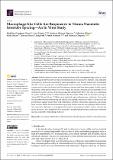Files in this item
Macrophage-like cells are responsive to titania nanotube intertube spacing—an in vitro study
Item metadata
| dc.contributor.author | Necula, Madalina Georgiana | |
| dc.contributor.author | Mazare, Anca | |
| dc.contributor.author | Negrescu, Andreea Mariana | |
| dc.contributor.author | Mitran, Valentina | |
| dc.contributor.author | Ozkan, Selda | |
| dc.contributor.author | Trusca, Roxana | |
| dc.contributor.author | Park, Jung | |
| dc.contributor.author | Schmuki, Patrik | |
| dc.contributor.author | Cimpean, Anisoara | |
| dc.date.accessioned | 2022-04-11T09:30:31Z | |
| dc.date.available | 2022-04-11T09:30:31Z | |
| dc.date.issued | 2022-03-24 | |
| dc.identifier | 278805088 | |
| dc.identifier | 30a02868-ecae-4777-a53c-754b27e67c92 | |
| dc.identifier | 85126890204 | |
| dc.identifier | 000781029600001 | |
| dc.identifier.citation | Necula , M G , Mazare , A , Negrescu , A M , Mitran , V , Ozkan , S , Trusca , R , Park , J , Schmuki , P & Cimpean , A 2022 , ' Macrophage-like cells are responsive to titania nanotube intertube spacing—an in vitro study ' , International Journal of Molecular Sciences , vol. 23 , no. 7 , 3558 . https://doi.org/10.3390/ijms23073558 | en |
| dc.identifier.issn | 1422-0067 | |
| dc.identifier.other | Jisc: 188375 | |
| dc.identifier.uri | https://hdl.handle.net/10023/25164 | |
| dc.description | The authors gratefully acknowledge support from Ministry of Research, Innovation and Digitalization through project 41PFE/30.12.3021. | en |
| dc.description.abstract | With the introduction of a new interdisciplinary field, osteoimmunology, today, it is well acknowledged that biomaterial-induced inflammation is modulated by immune cells, primarily macrophages, and can be controlled by nanotopographical cues. Recent studies have investigated the effect of surface properties in modulating the immune reaction, and literature data indicate that various surface cues can dictate both the immune response and bone tissue repair. In this context, the purpose of the present study was to investigate the effects of titanium dioxide nanotube (TNT) interspacing on the response of the macrophage-like cell line RAW 264.7. The cells were maintained in contact with the surfaces of flat titanium (Ti) and anodic TNTs with an intertube spacing of 20 nm (TNT20) and 80 nm (TNT80), under standard or pro-inflammatory conditions. The results revealed that nanotube interspacing can influence macrophage response in terms of cell survival and proliferation, cellular morphology and polarization, cytokine/chemokine expression, and foreign body reaction. While the nanostructured topography did not tune the macrophages’ differentiation into osteoclasts, this behavior was significantly reduced as compared to flat Ti surface. Overall, this study provides a new insight into how nanotubes’ morphological features, particularly intertube spacing, could affect macrophage behavior. | |
| dc.format.extent | 22 | |
| dc.format.extent | 6099321 | |
| dc.language.iso | eng | |
| dc.relation.ispartof | International Journal of Molecular Sciences | en |
| dc.subject | Macrophage | en |
| dc.subject | Inflammation | en |
| dc.subject | TiO2 nanotubes | en |
| dc.subject | Intertube spacing | en |
| dc.subject | Cytokines | en |
| dc.subject | Osteoclastogenesis | en |
| dc.subject | QR180 Immunology | en |
| dc.subject | NDAS | en |
| dc.subject.lcc | QR180 | en |
| dc.title | Macrophage-like cells are responsive to titania nanotube intertube spacing—an in vitro study | en |
| dc.type | Journal article | en |
| dc.contributor.institution | University of St Andrews. School of Chemistry | en |
| dc.identifier.doi | https://doi.org/10.3390/ijms23073558 | |
| dc.description.status | Peer reviewed | en |
This item appears in the following Collection(s)
Items in the St Andrews Research Repository are protected by copyright, with all rights reserved, unless otherwise indicated.

